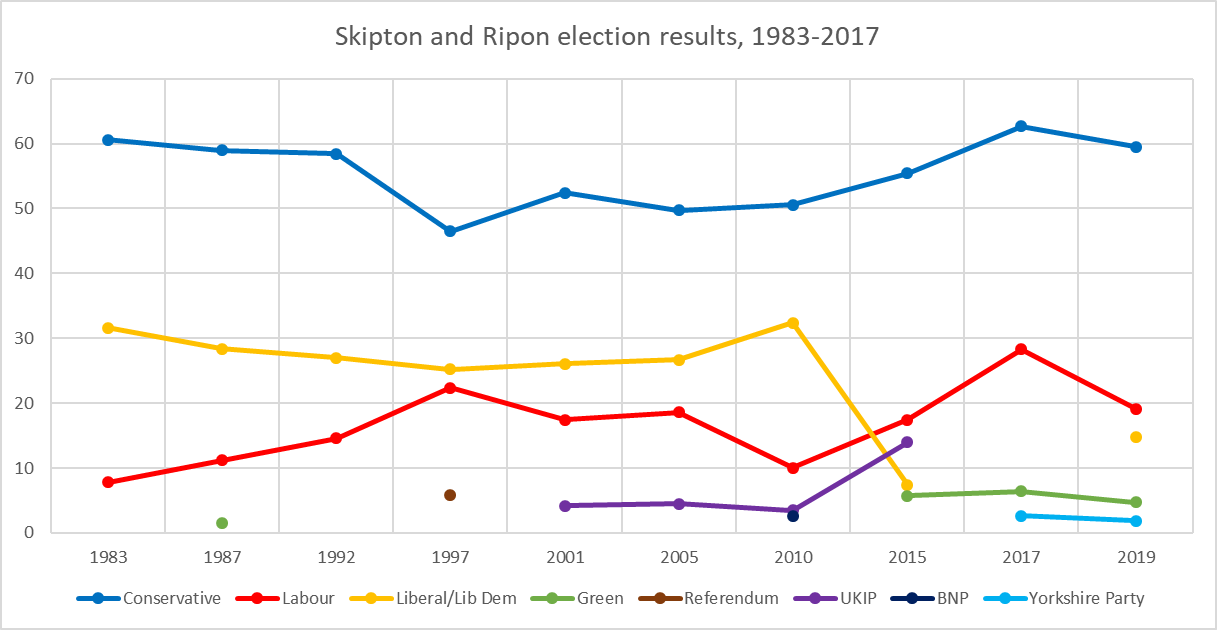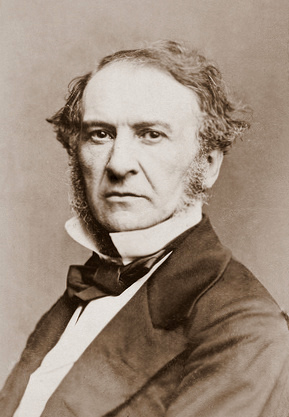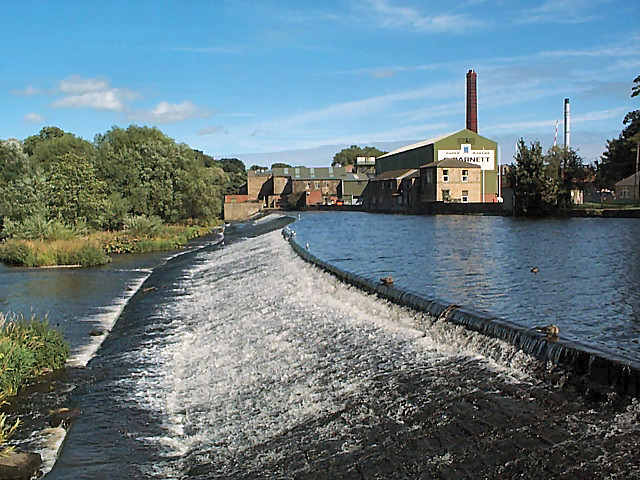|
Ripon (UK Parliament Constituency)
Ripon was a constituency sending members to the House of Commons of the Parliament of the United Kingdom until 1983, centred on the city of Ripon in North Yorkshire. History Ripon was first represented in the Model Parliament of 1295, and also returned members in 1307 and 1337, but it was not permanently represented until 1553, after which it returned two Members of Parliament. It was a parliamentary borough consisting only of the town of Ripon itself until the Great Reform Act of 1832; the right to vote was vested in the holders of the tightly controlled burgage tenements — count-of-head polls were accordingly rare — for, the last contested election in Ripon before the Reform Act 1832 was in 1715. By 1832 it was estimated that there were 43 men qualified to vote; the total of adult males over age 20 in the township in 1831 was recorded at 3,571. Such a burgeoning middle class population when considered under the 1832 Reform Act made for Ripon a relatively major b ... [...More Info...] [...Related Items...] OR: [Wikipedia] [Google] [Baidu] |
Skipton And Ripon (UK Parliament Constituency)
Skipton and Ripon is a constituency in North Yorkshire represented in the House of Commons of the UK Parliament since 2010 by Julian Smith, a Conservative. Constituency profile The constituency covers a mainly rural area of the Yorkshire Dales. The largest settlements are the town of Skipton and the city of Ripon. Smaller towns in the constituency are Bentham, Settle, Pateley Bridge and Masham. It is one of the safest seats in England, formed on an area with a long history of Conservative representation and with a large majority of its electorate having in the last election voted Conservative. It was also the constituency in 1992 that when declared, saw the Conservatives gain the 4th straight majority since 1979 and John Major re-elected as Prime Minister. At 1.6%, Skipton and Ripon had significantly lower than national average unemployment (3.8%) in November 2012. Boundaries 1983–1997: The District of Craven, and the Borough of Harrogate wards of Almscliffe, Bishop ... [...More Info...] [...Related Items...] OR: [Wikipedia] [Google] [Baidu] |
1868 United Kingdom General Election
The 1868 United Kingdom general election was the first after passage of the Reform Act 1867, which enfranchised many male householders, thus greatly increasing the number of men who could vote in elections in the United Kingdom. It was the first election held in the United Kingdom in which more than a million votes were cast; nearly triple the number of votes were cast compared to the previous election of 1865. The result saw the Liberals, led by William Gladstone, again increase their majority over Benjamin Disraeli's Conservatives ( see 1865 election) to more than 100 seats. This was the last general election at which all the seats were taken by only the two leading parties, although the parties at the time were loose coalitions and party affiliation was not listed on registration papers. Results Voting summary Seats summary Regional results Great Britain =England= =Scotland= =Wales= Ireland Universities See also * List of MPs elected in the 18 ... [...More Info...] [...Related Items...] OR: [Wikipedia] [Google] [Baidu] |
Thomas More II
Thomas More (1531–1606), of Hambleden, Buckinghamshire; Barnbrough, Yorkshire; Leyton, Essex and North Mimms, Hertfordshire, was an English politician. He was a Member (MP) of the Parliament of England for Ripon Ripon () is a cathedral city in the Borough of Harrogate, North Yorkshire, England. The city is located at the confluence of two tributaries of the River Ure, the Laver and Skell. Historically part of the West Riding of Yorkshire, the city ... in November 1554, during the reign of Mary I of England. Family More was the son of John More II (1510-1547), the only son of Sir Thomas More and his first wife Jane Colt (c.1488-1511). His paternal great-grandfather was lawyer and judge John More. References 1531 births 1606 deaths English MPs 1554–1555 People from Wycombe District People from the Metropolitan Borough of Doncaster People from Leyton People from Welwyn Hatfield (district) {{16thC-England-MP-stub ... [...More Info...] [...Related Items...] OR: [Wikipedia] [Google] [Baidu] |
John Temple (MP For Ripon)
John Temple (1518/19 – 1558 or later) was an English politician. He was a Member of Parliament, Member (MP) of the Parliament of England for Ripon (UK Parliament constituency), Ripon in April 1554 and for Great Bedwyn (UK Parliament constituency), Great Bedwyn in 1558. References 1510s births 16th-century deaths English MPs 1554 English MPs 1558 Members of Parliament for Great Bedwyn {{16thC-England-MP-stub ... [...More Info...] [...Related Items...] OR: [Wikipedia] [Google] [Baidu] |
William Rastell
William Rastell (150827 August 1565) was an English printer and judge. Life Rastell was born in London, a son of John Rastell and his wife Elizabeth More, sister of Sir Thomas More. At the age of seventeen he went to the University of Oxford, but did not take a degree, being probably called home to superintend the printing business of his father. He was MP for Hindon in October 1553 and for Ripon in April 1554 and for Canterbury in 1555. His office was in Fleet Street in St Bride's churchyard. He became a student at Lincoln's Inn on 12 September 1532, and gave up the printing business two years later. In 1547 he was appointed Reader. On account of his Catholic convictions he left England for Leuven; but upon the accession of Mary he returned, and was made Sergeant-at-law and Treasurer of Lincoln's Inn in 1555. His patent as judge of the Queen's Bench was granted on 27 October 1558. Rastell continued on the bench until 1562, when he retired to Leuven without the queen's licen ... [...More Info...] [...Related Items...] OR: [Wikipedia] [Google] [Baidu] |
Edward Beseley
Edward Beseley (by 1532 – 1613 or later), of York and Skelton in Overton, Yorkshire, was an English politician. He was a Member (MP) of the Parliament of England for Ripon in October 1553, for Thirsk in November 1554 and for Scarborough Scarborough or Scarboro may refer to: People * Scarborough (surname) * Earl of Scarbrough Places Australia * Scarborough, Western Australia, suburb of Perth * Scarborough, New South Wales, suburb of Wollongong * Scarborough, Queensland, su ... in 1558. References 17th-century deaths Politicians from York Year of birth uncertain English MPs 1553 (Mary I) English MPs 1554–1555 English MPs 1558 Members of the Parliament of England for constituencies in Yorkshire {{16thC-England-MP-stub ... [...More Info...] [...Related Items...] OR: [Wikipedia] [Google] [Baidu] |
Marmaduke Wyvill (MP For Ripon)
Marmaduke Wyvill (by 1496 – 1558), of Little Burton, Yorkshire, was an English politician. He was a Member (MP) of the Parliament of England for Ripon Ripon () is a cathedral city in the Borough of Harrogate, North Yorkshire, England. The city is located at the confluence of two tributaries of the River Ure, the Laver and Skell. Historically part of the West Riding of Yorkshire, the city ... in October 1553. References 15th-century births 1558 deaths English MPs 1553 (Mary I) Members of the Parliament of England for constituencies in Yorkshire {{16thC-England-MP-stub ... [...More Info...] [...Related Items...] OR: [Wikipedia] [Google] [Baidu] |
Otley
Otley is a market town and civil parishes in England, civil parish at a bridging point on the River Wharfe, in the City of Leeds metropolitan borough in West Yorkshire, England. Historic counties of England, Historically a part of the West Riding of Yorkshire, the population was 13,668 at the 2011 census. It is in two parts: south of the river is the historic town of Otley and to the north is Newall, West Yorkshire, Newall, which was formerly a separate township. The town is in lower Wharfedale on the A660 road which connects it to Leeds. The town is in the Otley and Yeadon (ward), Otley and Yeadon ward of Leeds City Council and the Leeds North West (UK Parliament constituency), Leeds North West UK Parliament constituencies, parliamentary constituency. History Toponymy Otley's name is derived from Otto, Otho, Othe, or Otta, a Saxon personal name and ''leah'', a woodland clearing in Old English. It was recorded as ''Ottanlege'' in 972 and ''Otelai'' or ''Othelia'' in the ''Dom ... [...More Info...] [...Related Items...] OR: [Wikipedia] [Google] [Baidu] |
Ilkley
Ilkley is a spa town and civil parish in the City of Bradford in West Yorkshire, in Northern England. Historically part of the West Riding of Yorkshire, Ilkley civil parish includes the adjacent village of Ben Rhydding and is a ward within the City of Bradford. Approximately north of Bradford and north-west of Leeds, the town lies mainly on the south bank of the River Wharfe in Wharfedale, one of the Yorkshire Dales. Ilkley's spa town heritage and surrounding countryside make tourism an important local industry. The town centre is characterised by Victorian architecture, wide streets and floral displays. Ilkley Moor, to the south of the town, is the subject of a folk song, often described as the unofficial anthem of Yorkshire, "On Ilkla Moor Baht 'at". The song's words are written in Yorkshire dialect, its title translated as "On Ilkley Moor without a hat." History The earliest evidence of habitation in the Ilkley area is from flint arrowheads or microliths, dating to the M ... [...More Info...] [...Related Items...] OR: [Wikipedia] [Google] [Baidu] |
Knaresborough
Knaresborough ( ) is a market and spa town and civil parish in the Borough of Harrogate, in North Yorkshire, England, on the River Nidd. It is east of Harrogate. History Knaresborough is mentioned in the Domesday Book of 1086 as ''Chenaresburg'', meaning "Cenheard's fortress", in the wapentake of Burghshire, renamed Claro Wapentake in the 12th century. Knaresborough Castle is Norman; around 1100, the town began to grow. It provided a market and attracted traders to service the castle. The parish church, St John's, was established around this time. The earliest identified Lord of Knaresborough is around 1115 when Serlo de Burgh held the Honour of Knaresborough from the King. Hugh de Morville was granted the Honour of Knaresborough in 1158. He was constable of Knaresborough and leader of the group of four knights who murdered Archbishop Thomas Becket at Canterbury Cathedral on 29 December 1170. The four knights fled to Knaresborough and hid at the castle. Hugh de Morvil ... [...More Info...] [...Related Items...] OR: [Wikipedia] [Google] [Baidu] |
Harrogate
Harrogate ( ) is a spa town and the administrative centre of the Borough of Harrogate in North Yorkshire, England. Historic counties of England, Historically in the West Riding of Yorkshire, the town is a tourist destination and its visitor attractions include its spa waters and Harlow Carr, RHS Harlow Carr gardens. away from the town centre is the Yorkshire Dales National Park and the Nidderdale AONB. Harrogate grew out of two smaller settlements, High Harrogate and Low Harrogate, in the 17th century. For three consecutive years (2013–2015), polls voted the town as "the happiest place to live" in Britain. Harrogate spa water contains iron, sulphur and common salt. The town became known as 'The English Spa' in the Georgian era, after its waters were discovered in the 16th century. In the 17th and 18th centuries its 'chalybeate' waters (containing iron) were a popular health treatment, and the influx of wealthy but sickly visitors contributed significantly to the wealth of th ... [...More Info...] [...Related Items...] OR: [Wikipedia] [Google] [Baidu] |
1950 United Kingdom General Election
The 1950 United Kingdom general election was the first ever to be held after a full term of Labour government. The election was held on Thursday 23 February 1950, and was the first held following the abolition of plural voting and university constituencies. The government's 1945 lead over the Conservative Party shrank dramatically, and Labour was returned to power but with an overall majority reduced from 146 to just 5. There was a 2.8% national swing towards the Conservatives, who gained 90 seats. Labour called another general election in 1951, which the Conservative Party won. Turnout increased to 83.9%, the highest turnout in a UK general election under universal suffrage, and representing an increase of more than 11% in comparison to 1945. It was also the first general election to be covered on television, although the footage was not recorded. Richard Dimbleby hosted the BBC coverage of the election, which he would later do again for the 1951, 1955, 1959 and the 1964 ... [...More Info...] [...Related Items...] OR: [Wikipedia] [Google] [Baidu] |





